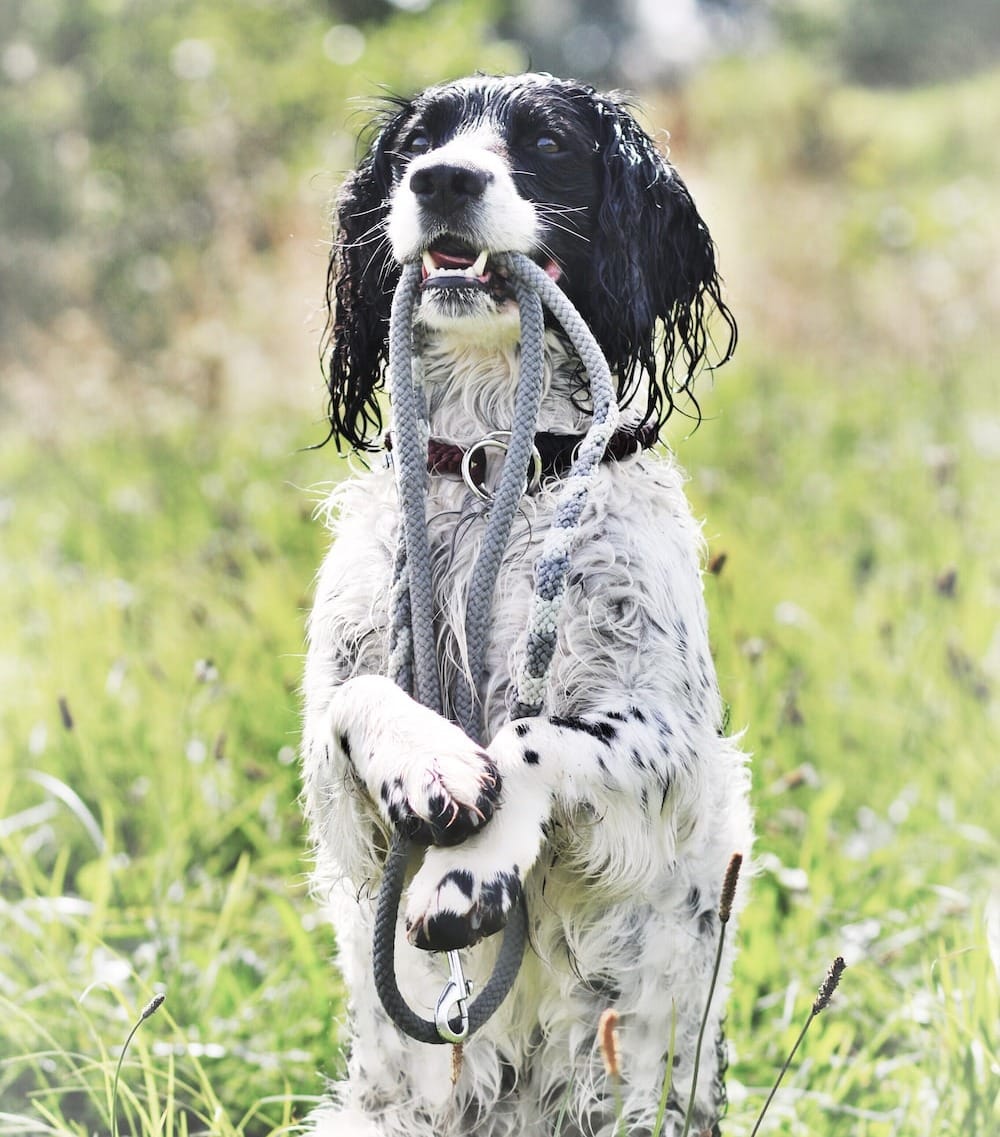If you've ever considered getting an English Springer Spaniel as a pet, you might have wondered about their trainability. Are English Springer Spaniels easy to train? Well, the good news is that with the right approach, training an English Springer Spaniel can be a rewarding experience.
Known for their intelligence and eagerness to please, English Springer Spaniels are generally quick learners and thrive with positive reinforcement training methods. They are highly trainable dogs and excel in various activities, including obedience, agility, and even search and rescue.

However, it's important to note that each dog is unique, and while the breed as a whole is known for being easy to train, individual personalities and temperaments can vary. Some English Springer Spaniels may require more time and patience during the training process.
Characteristics and Temperament of English Springer Spaniels
English Springer Spaniels are medium-sized dogs with a friendly and outgoing personality. They are known for their boundless energy and love of activity, making them an ideal choice for families or individuals who lead an active lifestyle. These dogs have a strong desire to please their owners and are highly sociable with both humans and other animals.
One of the key traits that make English Springer Spaniels easy to train is their intelligence. They are quick to learn and can easily grasp new commands and concepts. This intelligence, coupled with their high energy levels, makes them a versatile breed that excels in various training activities.
It's worth noting that English Springer Spaniels are also known for their strong hunting instincts. Originally bred as hunting dogs, they have a natural inclination to chase and retrieve. While this can make them excellent candidates for activities such as agility and search and rescue, it can also pose a challenge during training, especially if their instincts are not properly channeled.

Factors that Influence Trainability in Dogs
Before diving into the specifics of training English Springer Spaniels, it's important to understand the factors that can influence a dog's trainability. While breed characteristics play a significant role, several other factors come into play when it comes to training any dog.
- Genetics: The genetic makeup of a dog can influence their trainability. Some breeds are naturally more inclined to be obedient and easily trainable, while others may require more time and effort.
- Early Socialization: The experiences a dog has during their early development stages can shape their trainability. Proper socialization during puppyhood is crucial to ensure that a dog is exposed to different environments, people, and animals, which helps them become well-adjusted and more receptive to training.
- Consistency and Positive Reinforcement: Dogs thrive on consistency and positive reinforcement. Training methods that focus on rewarding desired behaviors rather than punishing unwanted ones have been proven to be more effective in training dogs.
- Handler's Skill and Patience: The handler's skill and level of patience can greatly impact a dog's trainability. Clear communication, consistency, and a calm demeanor are essential for successful training sessions.
:strip_icc()/ESSGettyImages-1140139727Nigel_Wallace-1aa0f57103cc449197c50da88edd2358.jpg)
Trainability of English Springer Spaniels
English Springer Spaniels are known for their trainability and willingness to please their owners. Their intelligence and eagerness to learn make them highly receptive to training. However, it's important to approach their training with patience, consistency, and positive reinforcement techniques.
Basic obedience training is an essential foundation for any dog, and English Springer Spaniels are no exception. Teaching them commands such as sit, stay, come, and heel not only helps in controlling their behavior but also strengthens the bond between the dog and the owner.
When training an English Springer Spaniel, it's important to keep training sessions short and engaging. These dogs have a short attention span, so breaking up training into smaller sessions throughout the day can yield better results. Additionally, incorporating fun and interactive activities such as retrieving games or puzzle toys can help keep them mentally stimulated during training.
Basic Obedience Training for English Springer Spaniels
- Sit: Start by holding a treat close to your dog's nose and slowly raise it above their head. As their nose follows the treat, their bottom will naturally lower into a sitting position. Once they are sitting, say the word "sit" and reward them with the treat.
- Stay: Begin with your dog in a sitting position. Hold your hand up, palm facing towards them, and say "stay" while taking a step back. If they stay in place, reward them with praise and a treat. Gradually increase the distance and duration of the stay.
- Come: Start by putting a long leash on your dog. Get down to their level, open your arms, and say "Come." Gently pull on the leash to guide them towards you. Once they reach you, reward them with praise and treats.
Remember to use positive reinforcement techniques such as treats, praise, and affection to reward your English Springer Spaniel for desired behaviors. This will motivate them to repeat those behaviors in the future.
Advanced Training for English Springer Spaniels
Once your English Springer Spaniel has mastered basic obedience commands, you can move on to more advanced training. These dogs excel in activities that challenge their intelligence and physical abilities. Here are a few examples of advanced training for English Springer Spaniels:
- Agility Training: Set up an agility course in your backyard or enroll your dog in agility classes. This activity involves navigating through obstacles such as jumps, tunnels, and weave poles. Agility training not only provides mental stimulation but also helps improve your dog's coordination and physical fitness.
- Search and Rescue Training: English Springer Spaniels have a keen sense of smell, which makes them excellent candidates for search and rescue work. Training them to find specific scents or locate missing persons can be a rewarding and purposeful activity for both you and your dog.
- Trick Training: Teach your English Springer Spaniel fun and entertaining tricks such as rolling over, playing dead, or dancing. Trick training not only stimulates their minds but also helps strengthen the bond between you and your furry companion.
Tips for Successful Training Sessions with English Springer Spaniels:
Training a dog, regardless of breed, can sometimes be challenging. Here are some tips to help make your training sessions with an English Springer Spaniel more successful:
- Be Consistent: Consistency is key when it comes to training. Use the same cues and commands consistently to avoid confusion. Establish a routine and stick to it.
- Start Early: Begin training your English Springer Spaniel as early as possible. Puppies have a natural curiosity and eagerness to learn, making them more receptive to training.
- Use Positive Reinforcement: Reward your dog with treats, praise, and affection when they exhibit desired behaviors. This positive reinforcement will motivate them to continue the behavior in the future.
- Keep Training Sessions Short: English Springer Spaniels have a short attention span, so keeping training sessions short and engaging will yield better results. Aim for multiple short sessions throughout the day rather than one long session.
- Be Patient: Training takes time and patience. Avoid getting frustrated or resorting to punishment. Stay calm and positive, and remember that each dog learns at their own pace.

Common Challenges in Training English Springer Spaniels
While English Springer Spaniels are generally easy to train, certain challenges may arise during the training process. It's important to be aware of these challenges and address them accordingly:
- High Energy Levels: English Springer Spaniels have a lot of energy, and if not properly channeled, it can be challenging to keep their focus during training sessions. Providing them with regular exercise and mental stimulation can help alleviate this challenge.
- Strong Hunting Instincts: As mentioned earlier, English Springer Spaniels have strong hunting instincts. This can make recall training and off-leash activities more challenging. It's important to prioritize training and reinforce obedience commands to ensure their safety.
- Selective Hearing: English Springer Spaniels can sometimes be stubborn and exhibit selective hearing. They may choose to ignore commands if they are not properly motivated or if they find something more interesting. Consistency and positive reinforcement are key to overcoming this challenge.

Recommended Training Resources for English Springer Spaniels
If you're looking for additional guidance and resources to assist you in training your English Springer Spaniel, consider the following:
- Professional Dog Training Classes: Enrolling your English Springer Spaniel in professional training classes can provide expert guidance and socialization opportunities.
- Online Training Courses: There are numerous online training courses and resources available that cater specifically to English Springer Spaniels. These courses can provide step-by-step instructions and valuable insights into training methods and techniques.
- Books and Literature: There are several books and literature dedicated to dog training, including specific resources for English Springer Spaniels. These can serve as valuable reference materials during your training journey.
Conclusion: Is the English Springer Spaniel Easy to Train?
In conclusion, training English Springer Spaniels is a gratifying experience, given their intelligence, eagerness to please, and inherent learning ability. Consistency, positive reinforcement, and patience are key elements in shaping a well-behaved companion. Prioritize mental and physical stimulation while asking, "Are English Springer Spaniels Easy to Train?" With the right investment of time and effort, you can foster obedience and happiness in your furry friend, creating a strong bond built on trust and mutual understanding.




